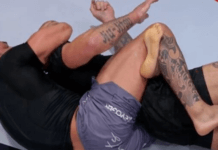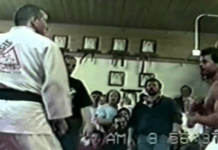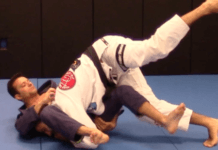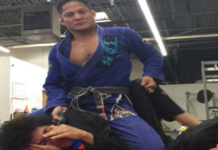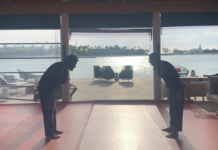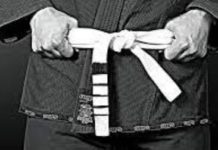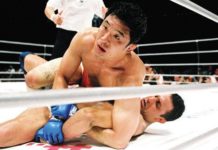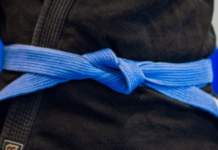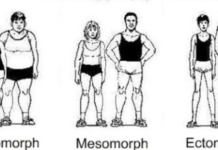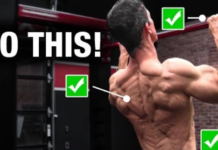Table of Contents
Grips are an insanely important part of Brazilian Jiu Jitsu. It is often said that whoever wins the grip game will win the entire fight. Most of the time, however, we are just focusing on how to improve our grip strengths and not thinking about basics. So, it’s high time to go back to basic and learn or remind what types of BJJ grips are out there, both in Gi and No Gi.
Why grips are so important in BJJ?
Grips simply mean control. The dominant grip will allow you to control the distance, secure a position or even finish a fight. Depending on the grip you have a different kind of control. With Gi grips, you got indirect leverage over a limb or body area, while No Gi grips provide you direct control. Regardless of that, both got simply the task of giving you maximal leverage over important body parts of your opponent. Without them, you can’t really pull off anything. In BJJ, there’s no way to achieve such a thing without getting a hold of the other person. Only with good, well-placed grips, you can start trying to sweep, finish, etc. When you’re looking to execute anything, from escapes to passes, you simply rely on grips. In conclusion, BJJ grips are just the basis for other things, everything starts from them.
Gi vs No Gi
Generally, Brazilian Jiu Jitsu can be divided into two categories, Gi and No Gi. It is no different with BJJ grips. They differ depending on whether we practice in gis or not. In gis, you can practically use any piece of material that you can catch. It also works the other way around, people will be wrapping you up tightly in every direction, using every little piece of cloth they can get their hands on. In Gi, grips mostly focus on three distinct points. Firstly the sleeves, especially its ends near the wrists. Secondly the pants, once again, mainly at their end, towards the ankles. And finally the collars and/or lapels (depending on the Gi’s position). Of course, you can use some other crazy grips, however, these are just the most fundamental for BJJ in gis.
In No Gi places of the grips are almost the same. You are still focused on arms, legs, and neck (which is the equivalent of a gi collar). The same as in gi, ankles, and wrists get the most attention. However, because you’re gripping directly in No Gi, your body and especially hand positioning will be a lot different than while fighting in gis. Due to this direct control, No Gi grips are also more dynamic. No Gi grips also do not provide as high control as those in a gi, which means you will be involved in a BJJ grip battle most of the time.
Types of BJJ grips
Once we know why grips are important, how do they differ in Gi and No Gi it’s hight time to time to find out what specific types of BJJ grips we have. Below you will find some of the most popular grips in Gi, No Gi and both of them at the same time.
Gi grips
The specificity of BJJ grips in gis lies in their indirectness. We grab our opponent’s gi here and not directly his limbs. So you have to understand that you need to get a very tight grip on the material, to have control over another person. The most popular method of doing this is making a “pocket” in your opponent’s gi by using your four fingers. In this case, the thumb goes on the outside to secure everything in place. This grip can also work in reverse, with the thumb in and four fingers out, although this is mainly for collar gripping. Next up is the pistol grip, when you grip the material like a handle of a pistol, thumb on top. Below you will find the specificity of specific grips divided according to their location. In Bjj grip strength is important factor so also focus on that.
Sleeves
Sleeves have two places where it is best to grab them. As mentioned above most used one is the end of the sleeve just above the wrist. Another popular choice is grabbing either above the elbow (triceps level) or high in the armpit. When it comes to finger positioning here four fingers grip is the most popular. This is due to the control in multiple directions it provides. Just remember gripping inside the sleeve is illegal. Make sure you keep all your fingers except the thumb out. Creating a pocket to obtain as much material as possible is best what you can do.
If for some reason you cannot use the method of gripping mentioned above you can always use pistol grip. This means your pinky is nearest to their wrist, with all your fingers holding as much of the material as a pistol handle. It is a great way to increase control over the opponent, plus add some discomfort due to the tightness of the sleeve. Just remember if others’ person sleeve is too tight you may not be able to catch this grip.
When it comes to less popular upper arm grips, the best place to grip is behind the triceps. The method to do so is a modified four-finger grip. However, due to the lack of the material in this location, upper arm grips need only be temporary solutions in a gripping fight.
Pants
Pants grips are an important part of controlling the legs. Thanks to them you can keep them in place, to work from the bottom or move them aside to pass from the top. As with sleeves, grips on the ends are the most popular. However, remember that you can also create pockets at knee level, for increased control of the shins or even grab material on the top of the pants for better hips control.
Regardless of where you grab, the four-finger grip is again the most popular here. And again putting your fingers inside the pants it’s just as illegal as putting it inside sleeves. The pistol grip is not as popular here as it was on the sleeves, because it doesn’t that much control. It is only good to consider while grabbing the end of the pants from the top. It can offer tight control over the material at the ankle level, which can result in a much higher degree of control over the leg and easier passing in turn.
Collar
Collar grip is different from the above ones because it provides not only control but also the possibility of submission via choke. There are two most popular methods of gripping the collar. The first is again four-finger one. In contrast to sleeves or pants, you can put your fingers inside the collar. The best way of doing this is to put all your fingers except for the thumb deep inside the collar of an opponent. The goal here is to grip the material tight by bending your fingers into a fist. The thumb has the role of securing the grip in place from the outside. Control is the main use of this grip. However, you can use it also for finishing techniques such as a loop choke.
The four-finger inside grip, however, is not the only popular method of gripping here. The other commonly used one is also the thumb in grip, which is the exact opposite of the previous one. In this grip, you have your thumb inside the collar and your other fingers are placed outside of the gi.
Grips used both in Gi and No Gi
While the application of these grips is mostly in No Gi, you can still use them while fighting in gi as well. Below you will find examples of some of the most common hand grips used both in Gi and No Gi.
Ball & Socket grip
To perform this grip you need to hide the “choking” hand under the other one. By ding that you make it harder for your opponent to grab and pull away. Just remember to do not grab your fingers and squish them. This will just put too much strain on the fingers. And your goal is to strengthen the wrist and forearm.
Ball & Socket or sometimes called Seat Belt grip is one of the most common and universal gripping methods in BJJ. It is widely used in several positions. You can use it while standing to control an opponent’s upper body, waist or legs in a sweep single type circumstance. Also, it is commonly used to secure the seat-belt position from the back and to finish chokes such as the guillotine.
This grip owes its popularity due to the fact it can be easily adjusted to hold grapplers of different sizes and cover different distances by adjusting the grip along the hand/forearm. At the same time, it can be also easily changed to the other grips.
Gable grip
It is a simple palm to palm grip. Despite its simplicity, it is an excellent grip for the clinching game because it allows you to control the distance and apply pressure. The gable is also highly applicable in submission techniques such as straight armlocks or chokes like the arm triangle. This grip owes its name to the legendary American wrestler Dan Gable – World champion and Olympic gold medalist. Other names for this gripping method are Gable Lock and Monkey Grip.
“S” grip
In this BJJ grip, you hook fingers-to-fingers in an “S” letter shape. It is a bit less universal than above mentioned gripping techniques. However, it is still very useful while clinching. You can just use it when your opponent is too big for your arms to wrap enough to go palm-to-palm. It can be also used to complete double-leg takedowns or some lifting techniques. Sometimes it is also named Chain Grip or Chain Hook.
No Gi grips
No Gi grips offer much less control, you just can’t grab one thing and hold it for the entire fight here. You need to be switching your grips constantly. Ant that’s why there are so many No Gi gripping methods. However, regardless of their multitude, their main purpose is the same as in gis. By using them you are looking for control or submission possibilities. Ones again below you will find the specificity of specific grips divided according to their location.
Arms
Just like in gis and No Gi, controlling your opponent’s arms is extremely important. It’s just harder here because you don’t have a gi to grab. The basic control patterns of the arms are about how many of your limbs you’re going to use to control another person. The best way to do this is to use both your arms to control one of your opponent’s arms.
To do so you can use a simple two-on-one BJJ grip. Just wrap both your hands around an opponent’s wrist. This will make it extremely difficult for them to escape. For you instead it is great because it gives you multiple options of control and attacks. You can also use a variation focusing on grabbing your opponent’s wrist and elbow on the same arm. It offers much better control than the double wrist grip. Alternatively, you can also go for one-on-one grips, controlling each arm with one of yours. This engages both arms but sacrifices a lot of control to do so.
Legs
Legs control in No Gi is mostly only temporary unless you’re going for leg locks. The main points you can catch on the leg are the foot, ankle, and knee. However, most of the time you just go for the ankle. It is the most common and useful one. You can hold it in one place or pull in the direction you want, depending on your positioning and goal.
If you want to go to knee control instead, the best way to do so is to place the fingers right behind the tendons of the knee joint. This offers a great anchor for your grip as well as huge control over an opponent. Just keep in mind that knee grips are much more useful when the leg is bent. Last but not least, foot control. It seems often forgotten, however, grabbing the foot of an opponent can be really good for your passing game and it is worth remembering about that. Moreover, due to the fact generally, legs are stronger than arms is good to use the simple but strong palm to palm grip most of the time when you want to control legs.
Head
In No Gi, you don’t want to control only your opponent’s legs or arms, but also his head. Most of the times people chose here the head and arm control. To do so with one of your arms you grab either the wrist or the elbow of an opponent. With the other one, you go at the back of the neck. This offers both direct arm control an postural control via the neck. It is a grip combination essential for No-Gi.
Hooks
It is again something really specific for No Gi. It is a bit more arm positioning than strict grip but still, it plays a huge role in grip fighting, therefore it is included here.
Hook grips mean using your arms to control either opponent’s arm or torso. Underhooks are just crucial for both passing and sweeping. To perform underhook correctly, you have ed to place your arms shoulder deep under the opponent’s armpit. Your palm should come out behind and stay on the back of their neck. Remember, you can go for underhooks on one side only, or on both sides of an opponent. For an overhook, you need instead to go with your arm over and around an opponent’s upper arm, to control it directly. Double overhooks are not an option, so better stick to the single side only.


